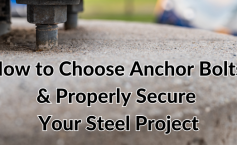Carbon steel is one of the most widely used materials in the world, and the 1018 and 1045 grades of steel is a big reason for that. One of the most common questions that arise when considering buying cold finished steel products is the difference between 1018 cold steel bars and 1045 cold bars. There will obviously be some differences between the chemical makeup and mechanical properties of both, but what materials are ideal for certain applications?
Chemical Properties
Being two different grades of steel, there are some important differences during the manufacturing process that influences key differences in the chemical properties of both 1018 and 1045 grades of steel. To best illustrate the chemical differences, it is good to reference a table.
| 1018 | 1045 | |
| Iron, Fe | 98.81-99.26% | 98.51-98.98% |
| Carbon, C | 0.18% | 0.45% |
| Manganese, Mn | 0.60-0.90% | 0.60-0.90% |
| Phosphorus, P (max) | 0.04% | 0.04% |
| Sulfur, S (max) | 0.05% | 0.05% |
As you may have noticed, the carbon content is what identifies the steel grade. The carbon content of 1018 is 0.18%, and the carbon content of 1045 steel is 0.45%. The “1” identifies that they are both carbon steels, and the “0” identifies that there were no modifications to the alloy. A carbon steel like 1330 for example has a much higher concentration of manganese. The carbon content is what really separates the chemical composition of 1018 and 1045, with 1045 steel having a higher carbon composition.
Mechanical Properties
Whether steel is cold drawn or hot rolled plays a huge factor in the mechanical properties of steel. The majority of 1018 and 1045 steel that is manufactured will be in the cold drawn state, and comes in a wide range of shapes and sizes. Here is a comparison chart of 1018 and 1045 cold drawn steel mechanical properties:
| 1018 | 1045 | |
| Tensile Strength | 64,000 psi | 91,000 psi |
| Yield Strength | 54,000 psi | 77,000 psi |
| Elongation in 2″ | 15% | 12% |
| Reduction in Area | 40% | 35% |
| Brinell Hardness | 126 | 179 |
Real Life Applications
With higher carbon content and higher tensile strength, 1045 is a stronger steel than 1018. However, because it has a higher carbon content, it is not as easy to weld. Therefore 1018 is used mostly for applications that may involve welding or require a larger quantity where tensile strength and yield strength is not of the highest importance. 1045 is often selected for product applications that require more strenth than 1018 can provide, such as transmission parts.
Cost
1018 is one of the most widely manufactured grades of steel as it is a cost effective and adequate steel option for a wide range of applications. Therefore 1018 steel will generally be a lower cost steel when compared to 1045, but many other factors can influence the overall cost like heat treatment and processing needs. For additional information on 1018 and 1045 please visit these pages:





